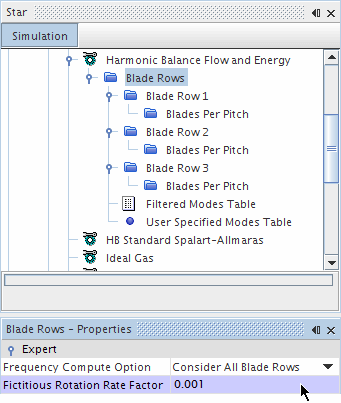Choosing a Fictitious Rotation Rate Factor
When you use Consider All Blade Rows as your Frequency Compute Option, every blade row must be assigned a different frequency for the purposes of computation.
This rule remains true even if some blade rows have identical frequencies in the User Specified Mode Table. Every blade is assigned an offset proportional to the Fictitious Rotation Rate Factor and to the maximum user-specified rotation rate .
The computation works up the blade rows, from last to first. The first time it comes to a blade that has the same frequency as a previous blade row, it adds an offset of . (The last row is compared to the first.) The next time that it comes to a blade that repeats a former frequency, it adds , and the next time , and so on. This addition guarantees that no two blades have identical frequencies.
For example, consider the blade rows described in the following table:
| 1st Stator
(1st Blade Row) |
1st Rotor
(2nd Blade Row) |
2nd Stator
(3rd Blade Row) |
2nd Rotor
(4th Blade Row) |
3rd Stator
(5th Blade Row) |
|
|---|---|---|---|---|---|
| User-Specified Rotation Rate | 0 | 0 | 0 | ||
| New Rotation Rate | 0 |
The computation begins from the last blade row (that is, the downstream stator, the third) and works backwards, adding a frequency offset if desired. The computation first adds an offset of to the downstream stator blade row (that is, the fifth blade row) because the relative rotation rate between this stator and the first stator (and also the third stator) is zero.
When the computation reaches the second rotor (fourth blade row), it adds an offset of because the relative rotation rate between this rotor and the first rotor (the second blade row) is zero.
When the computation reaches the middle stator (the third row), it adds an offset of because the relative rotation rate between this stator and the first stator is zero.
To set the Fictitious Rotation Rate factor, select the Blade Rows node, and set the value for the Fictitious Rotation Rate property.

The default value of is 0.001. It is best to make the value small, so the departure from the original value stays small. See Fictitious Rotation Rate Computation.
The offset is used only for entries in the modes table, not in computing the flow solution. The use of is required when using the Consider All Blade Rows option under the Frequency Compute Option. Using ensures that the unsteady solution at higher harmonics is exchanged between any two blade rows with the same rotation rate. The Fictitious Rotation Rate factor has no influence on the solution when the Consider Only Neighbors option is used.